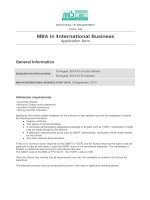international business
Bạn đang xem bản rút gọn của tài liệu. Xem và tải ngay bản đầy đủ của tài liệu tại đây (193.53 KB, 41 trang )
Copyright © 2011 by The McGraw-Hill Companies, Inc. All rights reserved.
McGraw-Hill/Irwin
International Business
Dr. K. Vogiatzoglou
( Dr. LOU )
Textbook:
Charles Hill, Global Business Today, 7
th
Edition,
McGraw-Hill/Irwin.
1-2
Aim of the Course
This course provides a review and analysis of the international
trade, investment, and business environment for managers.
It applies this knowledge to practical aspects of doing business
in international markets & managing firms in the globalized
economy.
Emphasis is given on the economic, geographical, historical,
legal and political factors that make international business
significantly different from domestic business activities.
The course points to real-world phenomena and issues of
contemporary globalization, and promotes an intuitive
understanding and creative thinking with regard to international
entrepreneurship and the global economic system.
1-3
Outline of the Course
Week 1 : Introduction to International Trade and to the Globalization Process
Week 2 : National Differences in Political Economy
Week 3 : Differences in Culture
Week 4 : International Trade Theory I
Week 5 : International Trade Theory II
Week 6 : The Political Economy of International Trade
Week 7 : Foreign Direct Investment
Week 8 : Review week
Week 9 : Mid-term exam
Week 10 : The Foreign Exchange Market
Week 11 : The International Monetary System
Week 12 : The Strategy of International Business
Week 13 : Entering Foreign Markets
Week 14 : Exporting, Importing, and Countertrade
Week 15 : Global Production, Outsourcing, and Logistics
Week 16 : Global Marketing and R&D
Week 17 : Review week
Week 18 : Final exam
1-4
Additional Information
There will be class discussions, one homework assignment, a
mid-term written exam, and a final written exam.
Scoring
Attendance: 25%
Homework assignment: 25%
Mid-term exam: 25%
Final exam: 25%
The course will also use alternative material (magazines,
internet sites, etc.) and topics discussed on TV that are relevant
to international trade, business, and cross-cultural co-operation.
1-5
Introduction
In the world economy today, we see
fewer self-contained national economies with high
barriers to cross-border trade and investment
a more integrated global economic system with lower
barriers to trade and investment
over $4 trillion in foreign exchange transactions daily
over $12 million of goods and $3.3 trillion of services
being sold across national borders
the establishment of international institutions
Chapter 1: Globalization
1-6
What Is Globalization?
Question: What is globalization?
Answer:
Globalization refers to the trend towards a more
integrated global economic system
Two key facets of globalization are:
the globalization of markets
the globalization of production
1-7
The Globalization of Markets
Globalization of markets - the merging of
historically distinct and separate national markets
into one huge global marketplace
In many markets today, the tastes and
preferences of consumers in different nations are
converging upon some global norm
Coca Cola, Starbucks, Sony PlayStation, and
McDonald’s hamburgers, IKEA furniture
1-8
The Globalization of Production
Globalization of production - the sourcing of
goods and services from locations around the
globe to take advantage of national differences in
the cost and quality of factors of production
(labor energy, land, and capital)
Goal: lower overall cost structure or improve the
quality or functionality of their product and gain
competitive advantage
Boeing and Vizio
1-9
The Emergence of Global Institutions
Global institutions
manage, regulate, and police the global market place
promote the establishment of multinational treaties to
govern the global business system
the World Trade Organization (WTO) - polices world
trading system and ensures nations adhere to the rules
established in WTO treaties
In 2010, its 154 members accounted for 97% of world
trade
the International Monetary Fund (IMF) - maintains order
in the international monetary system
1-10
The Emergence of Global Institutions
the World Bank - promotes economic development
the United Nations (UN) - maintains international peace
and security, develops friendly relations among nations,
cooperates in solving international problems and
promotes respect for human rights, and is a center for
harmonizing the actions of nations
1-11
Drivers of Globalization
Question: What is driving the move toward greater
globalization?
Answer:
1. declining trade and investment barriers
2. technological change
1-12
Declining Trade and Investment Barriers
International trade occurs when a firm exports goods or
services to consumers in another country
Foreign direct investment (FDI) occurs when a firm
invests resources in business activities outside its home
country
During the 1920s and 1930s, many nations erected
barriers to international trade and FDI to protect domestic
industries from foreign competition
1-13
Declining Trade and Investment Barriers
After WWII, advanced Western countries began
removing trade and investment barriers
Under GATT (the forerunner of the WTO), over 100
nations negotiated further decreases in tariffs and made
significant progress on a number of non-tariff issues
Under the WTO, a mechanism now exists for dispute
resolution and the enforcement of trade laws, and there
is a push to cut tariffs on industrial goods, services, and
agricultural products
1-14
Declining Trade and Investment Barriers
Lower trade barriers help companies view the world as a
single market and establish production activities in
optimal locations around the globe
This has led to an acceleration in the volume of world
trade and investment since the early 1980s
1-15
Declining Trade and Investment Barriers
Figure1.1: Growth in World Merchandise Trade and
Production, 1950 - 2008
1-16
The Role of Technological Change
Since World War II, there have been major advances in
communication, information processing, and
transportation
The microprocessor - lowered the cost of global
communication and the cost of coordinating and
controlling a global organization
U.S. web-based transactions - $133 billion in 2008
1.6 billion Internet users in 2009
Commercial jet aircraft and super freighters and the
introduction of containerization - simplify trans-
shipment from one mode of transport to another
1-17
The Role of Technological Change
Question: What are the implications of technological
change for the globalization of production?
Answer: Lower transportation costs make a
geographically dispersed production system more
economical and allow firms to better respond to
international customer demands
1-18
The Role of Technological Change
Question: What are the implications of technological
change for the globalization of markets?
Answer:
Low cost communications networks help create
electronic global marketplaces
Low cost transportation enable firms to create global
markets, and facilitate the movement of people from
country to country promoting a convergence of consumer
tastes and preferences
1-19
Changing Demographics of the Global Economy
In the 1960s:
the U.S. dominated the world economy and world trade
and world FDI
U.S. multinationals dominated the international business
scene
about half the world the centrally planned economies of
the communist world was off limits to Western
international business
Today, much of this has changed.
1-20
Changing World Output and World Trade Picture
In the early 1960s:
U.S. - dominant industrial power accounting for about
40.3% of world manufacturing output
By 2008:
U.S. accounted for only 20.7%
Other developed nations experienced a similar
decline
Rapid economic growth now in countries like China,
India, and Brazil
Further relative decline by the U.S. is likely
So companies may find both new markets and new
competitors in the developing regions of the world
1-21
Changing World Output and World Trade Picture
Table 1.2: The Changing Demographics of World GDP
and Trade
1-22
Changing Foreign Direct Investment Picture
The share of world output generated by developing
countries has been steadily increasing since the 1960s
The stock of foreign direct investment (total cumulative
value of foreign investments) generated by rich industrial
countries is declining
Cross-border flows of foreign direct investment are rising
The largest recipient of FDI is China
1-23
Changing Foreign Direct Investment Picture
Figure 1.2: Percentage Share of Total FDI Stock,
1980 - 2008
1-24
Changing Foreign Direct Investment Picture
Figure 1.3: FDI Inflows, 1988 - 2008
1-25
The Changing Multinational Enterprise
A multinational enterprise is any business that has
productive activities in two or more countries
Since the 1960s:
there has been a rise in non-U.S. multinationals
there has been a rise in mini-multinationals









